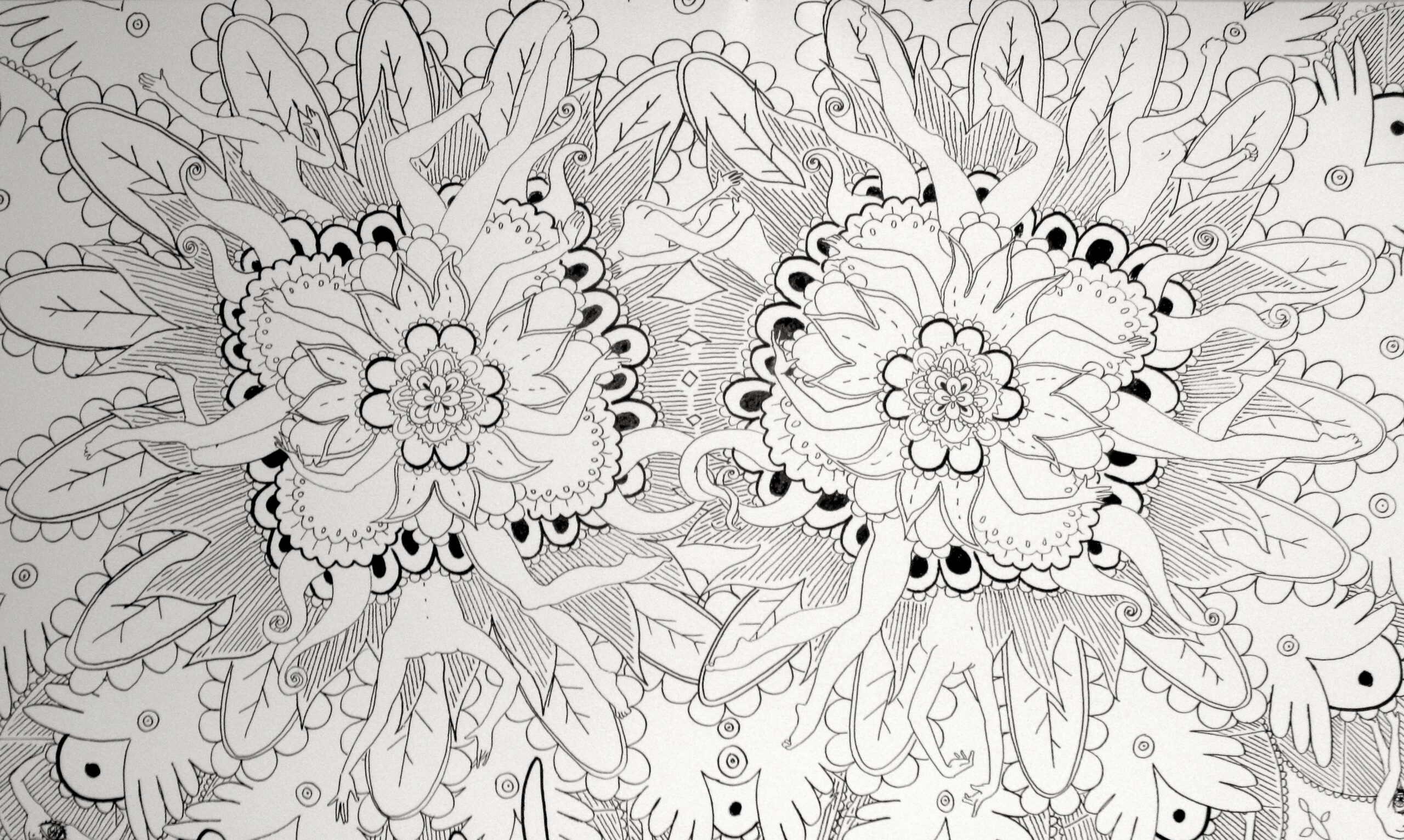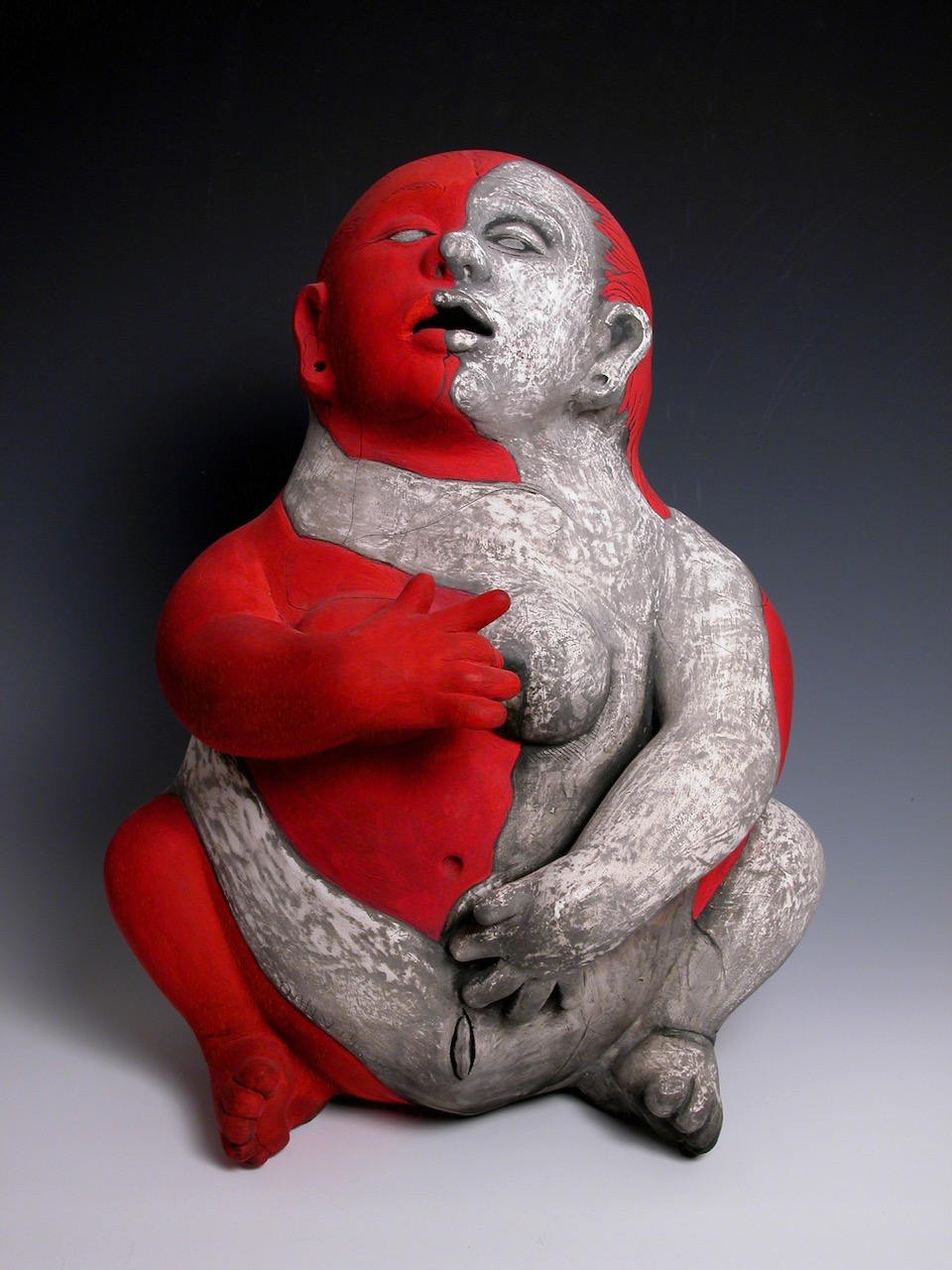Peruvian Kukuli Velarde confronts racism with striking ceramics based on historical works.
By ALICE THORSON
The Kansas City Star
Print :11/24/2013
Peruvian artist Kukuli Velarde is haunted by a childhood memory of her 16-year-old nanny, Lorenza.
“I don’t speak Quechua, ” Lorenza declared, and tried to hide her accent and thus, her indigenous roots.
Racism toward indigenous people in Peru can be subtle, and by most accounts is glossed over. But it exists.
It’s an attitude that goes back to the Spanish conquest – an important touchstone of Velarde’s work – and it makes her angry. She tackles the topic head on in her aggressively titled exhibit, “Plunder Me, Baby, ” at the Nerman Museum of Contemporary Art.
All 10 of the ceramic sculptures in the show are based on works of art from pre-Columbian civilizations. Velarde acknowledges her specific sources in her titles, and maintains their traditional shapes and painted designs. But she also changes them. By substituting her own face for the historical countenances and adding striking naturalistic eyes, Velarde turns these historical works into vehicles for her own ideas and commentary.
The results are striking, grotesque and sometimes violent, as seen in “Desperate House Help” (2009). Based on a 700 A.D. Moche stirrup spout vessel, the piece speaks to a Peruvian class system in which indigenous women are consigned to work as domestics.
This woman has had enough.
Her face is covered in blood and her thrown-back head exposes a slit throat. Another thing that makes this piece so disturbing is the figure’s contorted position – her head rests on her knees, but she faces up.
Titles are an important part of Velarde’s campaign, which seeks to reinstill cultural pride as well as combat racism. As Velarde summed it up in a recent talk at the Nerman, “The whiter you are the better you are.”
Many of the titles incorporate insults, “the same ones I have endured because of my indigenous ancestry, ” she says.
“They all have my face, ” Velarde explains in her artist’s statement, “for I had to become each of them to reclaim ownership and to take the name calling with defiance.”
Her piece, “A La Cholitranca se le salió el indio!, ” which translates to “savage aboriginal bitch, ” presents a total shift in attitude from the desperate and bleeding domestic.
Shaking her fists and grimacing with determination, this woman puts up a struggle against the forces that would drag her down, represented by a snake that has twined itself around her neck and body. The piece is based on a 200 A.D. Moche vessel, but the work’s animation and sense of emotional urgency is all Velarde’s.
“Think of traditional vessels. They’re all very stoic looking; you wouldn’t see emotion, ” said the Nerman’s executive director Bruce Hartman, who organized the exhibition. “What drew me to these initially was the artist’s background and what she’s doing to pre-Columbian works in clay, giving them personality and making them more confrontational.”
Velarde, now based in Philadelphia, earned her bachelor in fine arts degree from Hunter College of the City University of New York. Her work took a political turn in 1992, in response to celebrations of the 500th anniversary of Columbus – what Velarde calls “the invasion of Europe in America.”
She created “We the Colonized Ones, ” a series of ceramic babies that she carried with her on the subway. “Their parents were killed in the genocide, ” she said during a slide show at the Nerman. “Fifty to 100 million people died.”
She also showed “Isichapuitu” (1997-2005) a group of ceramic figures based on a pre-Columbian piece she discovered in a book. “The figure was two thousand years old and represented an obese male child with his arms up, ” she explains on her website. “Somebody made it two thousand years ago, and yet I believe, it looks like me.”
Velarde used a press mold to create 74 versions of the figure; each is different and represents a different thought.
Velarde contrasts the respect accorded pre-Columbian art with treatment of their descendants, noting “how easy it is to detach the makers from the objects.”
While Quechua dates to the Incas and is still spoken today, Spanish, as author Anna Saroli pointed out in a 2001 article in the Cultural Survival Quarterly, “is the language of power.”
“There exists a strange dichotomy between the pride in the history and culture of the Inca Empire (promoted by government and tourist sectors) and the disdain with which the living descendants of this empire are regarded, ” Saroli noted. “The unfortunate result of these attitudes is that many Quechua speakers hide their linguistic roots.”
Velarde is saddened and infuriated by this cultural denial, fighting back with works like “Najallota Insolente Maya México, 750 BC Playfully disobedient. Does not believe in hierarchies, la hija de la gran. …”
This woman combats her situation with impudence, sticking her tongue out at all who would try to put her down.
In other works, Velarde revisits the violence against women that was part of the conquest and is replayed today in the sexual exploitation of powerless female workers in menial jobs.
“Native Hysteric Macuarra” is a portrait of distress; arms and legs raised in self defense, mouth open in a scream. Velarde’s extended title describes her as “Vulnerable, defenseless. A fascinating prey. She gets scared easy.”
Encompassing a range of emotions and situations, from fury and resentment to innocence and submission, Velarde’s objects give voice to the historically voiceless, while expressing solidarity with their descendants.
In a posted statement, she dedicates this body of work to her nanny Lorenza and points out, “They show, in their attitudes and gestures, the rebellious spirit that should never abandon our hearts.”
To reach Alice Thorson, art critic, call 816-234-4763 or send email to athorson@kcstar.com.
On exhibit
“Kukuli Velarde: Plunder Me, Baby” continues at the Nerman Museum of Contemporary Art at Johnson County Community College, 12345 College Blvd., Overland Park, through Dec. 22. Hours are 10 a.m. to 5 p.m. Tuesday, Wednesday, Thursday and Saturday; 10 a.m. to 9 p.m. Friday; noon to 5 p.m. Sunday. Closed Monday and Nov. 27-29. The exhibit is free. For more information, call 913-469-3000 or go to nermanmuseum.org.



